Somnath Dey
DyFFPAD: Dynamic Fusion of Convolutional and Handcrafted Features for Fingerprint Presentation Attack Detection
Aug 19, 2023



Abstract:Automatic fingerprint recognition systems suffer from the threat of presentation attacks due to their wide range of applications in areas including national borders and commercial applications. Presentation attacks can be performed by fabricating the fake fingerprint of a user with or without the intention of the subject. This paper presents a dynamic ensemble of deep learning and handcrafted features to detect presentation attacks in known-material and unknown-material protocols. The proposed model is a dynamic ensemble of deep CNN and handcrafted features empowered deep neural networks both of which learn their parameters together. The proposed presentation attack detection model, in this way, utilizes the capabilities of both classification techniques and exhibits better performance than their individual results. The proposed model's performance is validated using benchmark LivDet 2015, 2017, and 2019 databases, with an overall accuracy of 96.10\%, 96.49\%, and 95.99\% attained on them, respectively. The proposed model outperforms state-of-the-art methods in benchmark protocols of presentation attack detection in terms of classification accuracy.
Automatic Signboard Recognition in Low Quality Night Images
Aug 17, 2023



Abstract:An essential requirement for driver assistance systems and autonomous driving technology is implementing a robust system for detecting and recognizing traffic signs. This system enables the vehicle to autonomously analyze the environment and make appropriate decisions regarding its movement, even when operating at higher frame rates. However, traffic sign images captured in inadequate lighting and adverse weather conditions are poorly visible, blurred, faded, and damaged. Consequently, the recognition of traffic signs in such circumstances becomes inherently difficult. This paper addressed the challenges of recognizing traffic signs from images captured in low light, noise, and blurriness. To achieve this goal, a two-step methodology has been employed. The first step involves enhancing traffic sign images by applying a modified MIRNet model and producing enhanced images. In the second step, the Yolov4 model recognizes the traffic signs in an unconstrained environment. The proposed method has achieved 5.40% increment in mAP@0.5 for low quality images on Yolov4. The overall mAP@0.5 of 96.75% has been achieved on the GTSRB dataset. It has also attained mAP@0.5 of 100% on the GTSDB dataset for the broad categories, comparable with the state-of-the-art work.
An Open Patch Generator based Fingerprint Presentation Attack Detection using Generative Adversarial Network
Jun 06, 2023



Abstract:The low-cost, user-friendly, and convenient nature of Automatic Fingerprint Recognition Systems (AFRS) makes them suitable for a wide range of applications. This spreading use of AFRS also makes them vulnerable to various security threats. Presentation Attack (PA) or spoofing is one of the threats which is caused by presenting a spoof of a genuine fingerprint to the sensor of AFRS. Fingerprint Presentation Attack Detection (FPAD) is a countermeasure intended to protect AFRS against fake or spoof fingerprints created using various fabrication materials. In this paper, we have proposed a Convolutional Neural Network (CNN) based technique that uses a Generative Adversarial Network (GAN) to augment the dataset with spoof samples generated from the proposed Open Patch Generator (OPG). This OPG is capable of generating realistic fingerprint samples which have no resemblance to the existing spoof fingerprint samples generated with other materials. The augmented dataset is fed to the DenseNet classifier which helps in increasing the performance of the Presentation Attack Detection (PAD) module for the various real-world attacks possible with unknown spoof materials. Experimental evaluations of the proposed approach are carried out on the Liveness Detection (LivDet) 2015, 2017, and 2019 competition databases. An overall accuracy of 96.20\%, 94.97\%, and 92.90\% has been achieved on the LivDet 2015, 2017, and 2019 databases, respectively under the LivDet protocol scenarios. The performance of the proposed PAD model is also validated in the cross-material and cross-sensor attack paradigm which further exhibits its capability to be used under real-world attack scenarios.
EXPRESSNET: An Explainable Residual Slim Network for Fingerprint Presentation Attack Detection
May 16, 2023



Abstract:Presentation attack is a challenging issue that persists in the security of automatic fingerprint recognition systems. This paper proposes a novel explainable residual slim network that detects the presentation attack by representing the visual features in the input fingerprint sample. The encoder-decoder of this network along with the channel attention block converts the input sample into its heatmap representation while the modified residual convolutional neural network classifier discriminates between live and spoof fingerprints. The entire architecture of the heatmap generator block and modified ResNet classifier works together in an end-to-end manner. The performance of the proposed model is validated on benchmark liveness detection competition databases i.e. Livdet 2011, 2013, 2015, 2017, and 2019 and the classification accuracy of 96.86\%, 99.84\%, 96.45\%, 96.07\%, 96.27\% are achieved on them, respectively. The performance of the proposed model is compared with the state-of-the-art techniques, and the proposed method outperforms state-of-the-art methods in benchmark protocols of presentation attack detection in terms of classification accuracy.
MoSFPAD: An end-to-end Ensemble of MobileNet and Support Vector Classifier for Fingerprint Presentation Attack Detection
Mar 02, 2023



Abstract:Automatic fingerprint recognition systems are the most extensively used systems for person authentication although they are vulnerable to Presentation attacks. Artificial artifacts created with the help of various materials are used to deceive these systems causing a threat to the security of fingerprint-based applications. This paper proposes a novel end-to-end model to detect fingerprint Presentation attacks. The proposed model incorporates MobileNet as a feature extractor and a Support Vector Classifier as a classifier to detect presentation attacks in cross-material and cross-sensor paradigms. The feature extractor's parameters are learned with the loss generated by the support vector classifier. The proposed model eliminates the need for intermediary data preparation procedures, unlike other static hybrid architectures. The performance of the proposed model has been validated on benchmark LivDet 2011, 2013, 2015, 2017, and 2019 databases, and overall accuracy of 98.64%, 99.50%, 97.23%, 95.06%, and 95.20% is achieved on these databases, respectively. The performance of the proposed model is compared with state-of-the-art methods and the proposed method outperforms in cross-material and cross-sensor paradigms in terms of average classification error.
A Novel Approach for Partial Fingerprint Identification to Mitigate MasterPrint Generation
Nov 08, 2019



Abstract:Partial fingerprint recognition is a method to recognize an individual when the sensor size has a small form factor in accepting a full fingerprint. It is also used in forensic research to identify the partial fingerprints collected from the crime scenes. But the distinguishing features in the partial fingerprint are relatively low due to small fingerprint captured by the sensor. Hence, the uniqueness of a partial fingerprint cannot be guaranteed, leading to a possibility that a single partial fingerprint may identify multiple subjects. A MasterPrint is a partial fingerprint that identifies at least 4% different individuals from the enrolled template database. A fingerprint identification system with such a flaw can play a significant role in convicting an innocent in a criminal case. We propose a partial fingerprint identification approach that aims to mitigate MasterPrint generation. The proposed method, when applied to partial fingerprint dataset cropped from standard FVC 2002 DB1(A) dataset showed significant improvement in reducing the count of MasterPrints. The experimental result demonstrates improved results on other parameters, such as True match Rate (TMR) and Equal Error Rate (EER), generally used to evaluate the performance of a fingerprint biometric system.
Fingerprint liveness detection using local quality features
Jun 08, 2018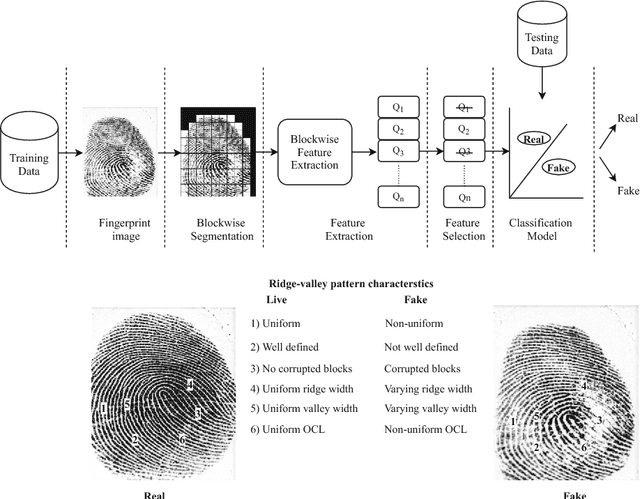
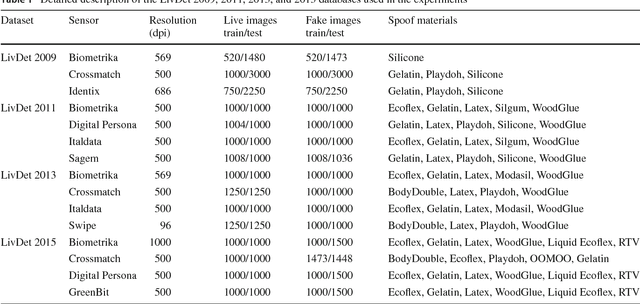
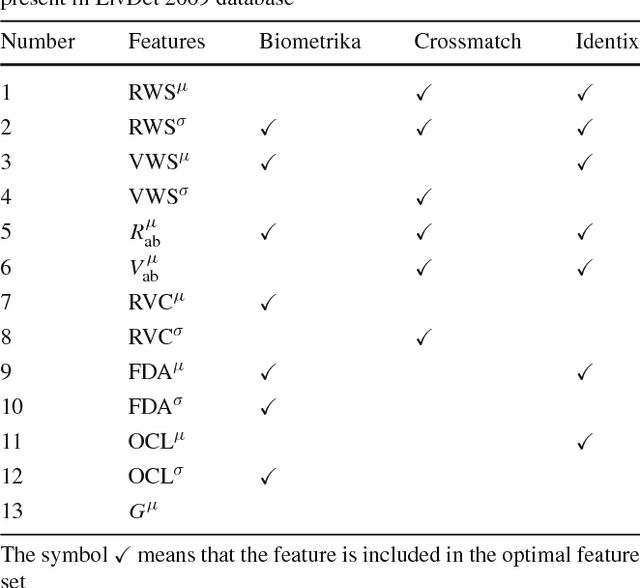
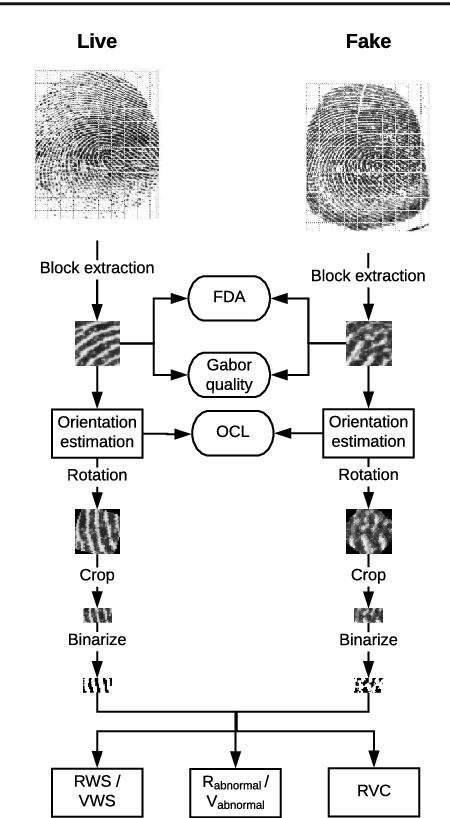
Abstract:Fingerprint-based recognition has been widely deployed in various applications. However, current recognition systems are vulnerable to spoofing attacks which make use of an artificial replica of a fingerprint to deceive the sensors. In such scenarios, fingerprint liveness detection ensures the actual presence of a real legitimate fingerprint in contrast to a fake self-manufactured synthetic sample. In this paper, we propose a static software-based approach using quality features to detect the liveness in a fingerprint. We have extracted features from a single fingerprint image to overcome the issues faced in dynamic software-based approaches which require longer computational time and user cooperation. The proposed system extracts 8 sensor independent quality features on a local level containing minute details of the ridge-valley structure of real and fake fingerprints. These local quality features constitutes a 13-dimensional feature vector. The system is tested on a publically available dataset of LivDet 2009 competition. The experimental results exhibit supremacy of the proposed method over current state-of-the-art approaches providing least average classification error of 5.3% for LivDet 2009. Additionally, effectiveness of the best performing features over LivDet 2009 is evaluated on the latest LivDet 2015 dataset which contain fingerprints fabricated using unknown spoof materials. An average classification error rate of 4.22% is achieved in comparison with 4.49% obtained by the LivDet 2015 winner. Further, the proposed system utilizes a single fingerprint image, which results in faster implications and makes it more user-friendly.
A non-invertible cancelable fingerprint template generation based on ridge feature transformation
May 28, 2018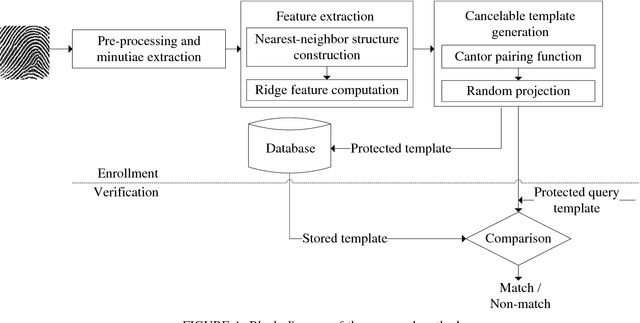
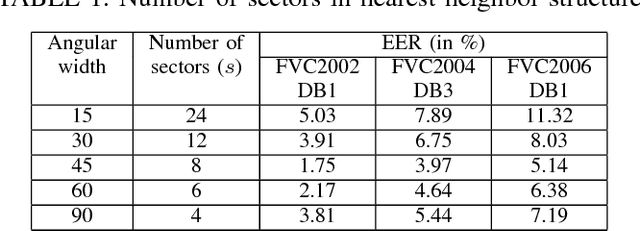
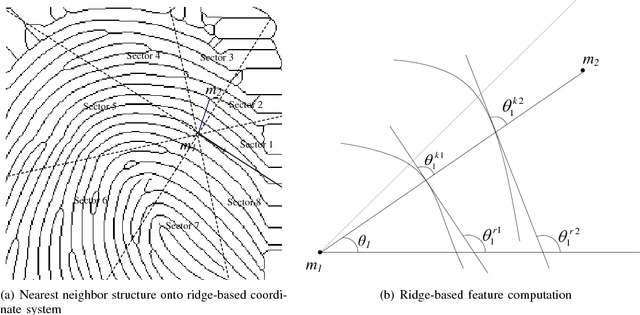
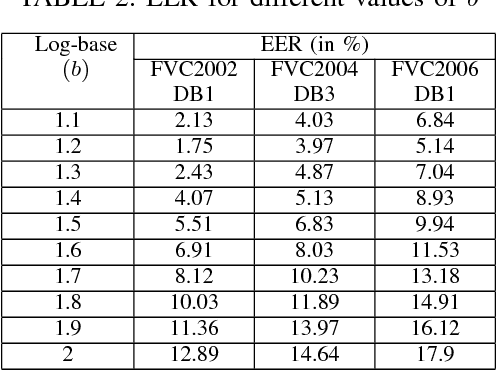
Abstract:In a biometric verification system, leakage of biometric data leads to permanent identity loss since original biometric data is inherently linked to a user. Further, various types of attacks on a biometric system may reveal the original template and utility in other applications. To address these security and privacy concerns cancelable biometric has been introduced. Cancelable biometric constructs a protected template from the original biometric template using transformation functions and performs the comparison between templates in the transformed domain. Recent approaches towards cancelable fingerprint generation either rely on aligning minutiae points with respect to singular points (core/delta) or utilize the absolute coordinate positions of minutiae points. In this paper, we propose a novel non-invertible ridge feature transformation method to protect the original fingerprint template information. The proposed method partitions the fingerprint region into a number of sectors with reference to each minutia point employing a ridge-based co-ordinate system. The nearest neighbor minutiae in each sector are identified, and ridge-based features are computed. Further, a cancelable template is generated by applying the Cantor pairing function followed by random projection. We have evaluated our method with FVC2002, FVC2004 and FVC2006 databases. It is evident from the experimental results that the proposed method outperforms existing methods in the literature. Moreover, the security analysis demonstrates that the proposed method fulfills the necessary requirements of non-invertibility, revocability, and diversity with a minor performance degradation caused due to cancelable transformation.
A novel hybrid score level and decision level fusion scheme for cancelable multi-biometric verification
May 26, 2018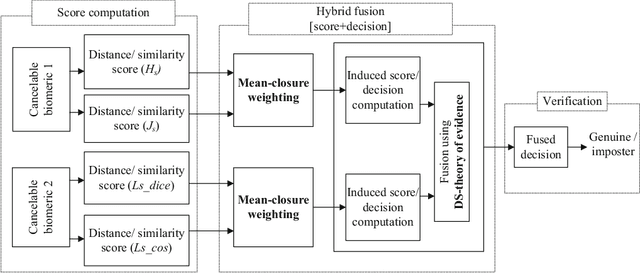
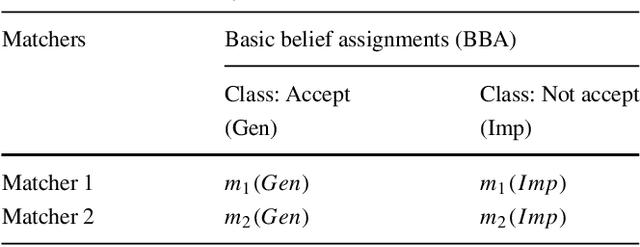
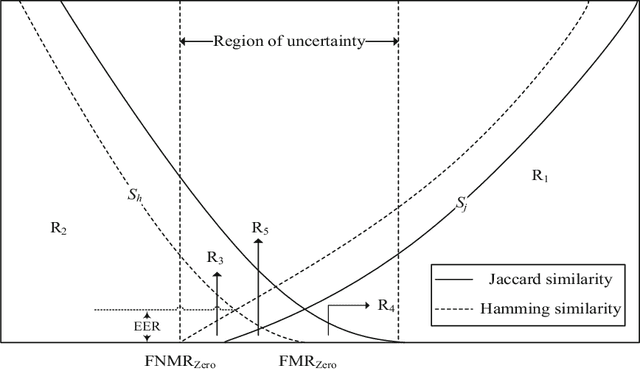
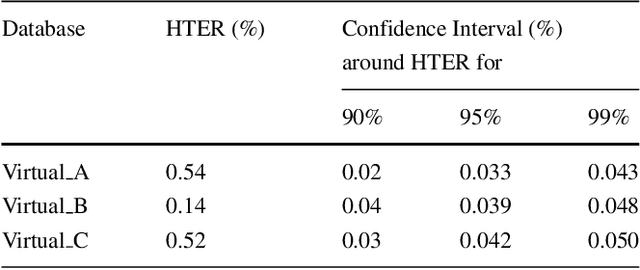
Abstract:In spite of the benefits of biometric-based authentication systems, there are few concerns raised because of the sensitivity of biometric data to outliers, low performance caused due to intra-class variations and privacy invasion caused by information leakage. To address these issues, we propose a hybrid fusion framework where only the protected modalities are combined to fulfill the requirement of secrecy and performance improvement. This paper presents a method to integrate cancelable modalities utilizing mean-closure weighting (MCW) score level and Dempster-Shafer (DS) theory based decision level fusion for iris and fingerprint to mitigate the limitations in the individual score or decision fusion mechanisms. The proposed hybrid fusion scheme incorporates the similarity scores from different matchers corresponding to each protected modality. The individual scores obtained from different matchers for each modality are combined using MCW score fusion method. The MCW technique achieves the optimal weight for each matcher involved in the score computation. Further, DS theory is applied to the induced scores to output the final decision. The rigorous experimental evaluations on three virtual databases indicate that the proposed hybrid fusion framework outperforms over the component level or individual fusion methods (score level and decision level fusion). As a result, we achieve (48%,66%), (72%,86%) and (49%,38%) of performance improvement over unimodal cancelable iris and unimodal cancelable fingerprint verification systems for Virtual_A, Virtual_B and Virtual_C databases, respectively. Also, the proposed method is robust enough to the variability of scores and outliers satisfying the requirement of secure authentication.
Generating protected fingerprint template utilizing coprime mapping transformation
May 25, 2018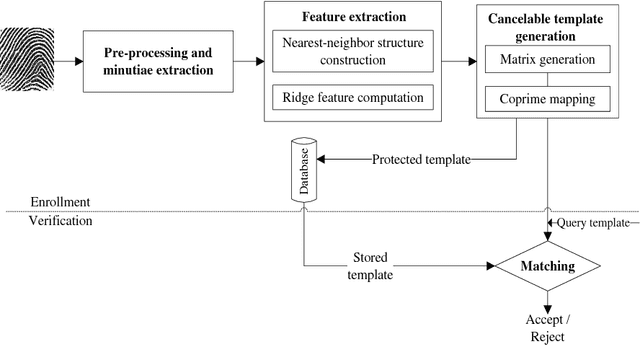



Abstract:The identity of a user is permanently lost if biometric data gets compromised since the biometric information is irreplaceable and irrevocable. To revoke and reissue a new template in place of the compromised biometric template, the idea of cancelable biometrics has been introduced. The concept behind cancelable biometric is to irreversibly transform the original biometric template and perform the comparison in the protected domain. In this paper, a coprime transformation scheme has been proposed to derive a protected fingerprint template. The method divides the fingerprint region into a number of sectors with respect to each minutiae point and identifies the nearest-neighbor minutiae in each sector. Then, ridge features for all neighboring minutiae points are computed and mapped onto co-prime positions of a random matrix to generate the cancelable template. The proposed approach achieves an EER of 1.82, 1.39, 4.02 and 5.77 on DB1, DB2, DB3 and DB4 datasets of the FVC2002 and an EER of 8.70, 7.95, 5.23 and 4.87 on DB1, DB2, DB3 and DB4 datasets of FVC2004 databases, respectively. Experimental evaluations indicate that the method outperforms in comparison to the current state-of-the-art. Moreover, it has been confirmed from the security analysis that the proposed method fulfills the desired characteristics of diversity, revocability, and non-invertibility with a minor performance degradation caused by the transformation.
 Add to Chrome
Add to Chrome Add to Firefox
Add to Firefox Add to Edge
Add to Edge